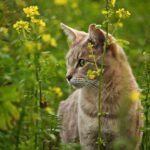Disturbing new research reveals that jaguars and pumas in damaged tropical forests are increasingly preying on monkeys, a dietary shift that signals ecosystem collapse. Scientists studying big cat behavior found that these apex predators, who typically prefer ground-dwelling prey like deer and peccaries, are being forced to hunt arboreal primates more frequently.
This change indicates either shrinking populations of traditional prey species or fundamental alterations in the forest ecosystem that make normal hunting patterns impossible. The implications are severe for both predators and prey – monkeys aren’t nutritionally optimal for big cats, while increased predation pressure threatens already vulnerable primate populations. This dietary shift serves as a critical warning about how habitat degradation cascades through entire food webs, ultimately threatening the survival of iconic species.
Why Big Cats Eat More Monkeys Now
Image by pexels
The shift in big cat diets represents a fundamental breakdown in tropical forest ecosystems. Jaguars and pumas evolved to hunt terrestrial prey – their powerful builds and hunting strategies are optimized for taking down deer, peccaries, tapirs, and capybaras. Switching to monkeys indicates desperation born from ecological disruption.
Damaged forests lose their understory vegetation first, eliminating cover that ground-dwelling prey need for protection. Without adequate hiding spots, populations of preferred prey species crash. Big cats must then expend more energy hunting whatever remains available – including arboreal primates.
Hunting monkeys requires different skills and more energy than catching ground prey. Cats must climb trees, navigate branches, and catch agile primates that can escape through the canopy. This inefficient hunting method provides less nutrition for greater effort, creating an energy deficit for predators.
The dietary shift also reflects forest fragmentation effects. As continuous forests become isolated patches, normal prey migration patterns break down. Big cats trapped in degraded fragments have limited hunting options, forcing them to target species they’d normally ignore.
Cascade Effects on Forest Ecosystems
When big cats eat more monkeys, the impacts ripple throughout the ecosystem. Primates play crucial roles as seed dispersers for many tropical trees. They consume fruits and spread seeds through their feces across large distances, maintaining forest diversity and regeneration.
Reduced monkey populations mean fewer seeds get dispersed, accelerating forest degradation. Trees that depend on primates for reproduction gradually disappear, further simplifying the ecosystem. This creates a negative feedback loop where forest damage leads to more forest damage.
Big cats themselves suffer from this dietary change. Monkeys provide less meat relative to hunting effort compared to traditional prey. Cats must hunt more frequently, increasing their exposure to human conflict and exhaustion. Nutritional stress weakens immune systems and reduces breeding success.
The presence of big cats in the canopy also disrupts monkey behavior and social structures. Primates must spend more time vigilant and less time feeding or socializing. This chronic stress reduces their own reproductive success, accelerating population declines.
What Forest Damage Means
Image by pexels
The research findings indicate that seemingly intact forests may be ecologically empty. A forest might appear green from above while missing crucial components of a functioning ecosystem. Without adequate prey bases, even protected areas become unsuitable for sustaining big cat populations.
Logging, even selective harvesting, disrupts delicate predator-prey balances. Removing large trees eliminates monkey travel routes and nesting sites. Ground disturbance from logging equipment destroys understory vegetation that shelters terrestrial prey. These impacts persist for decades after logging stops.
Climate change compounds forest damage through altered rainfall patterns and increased temperatures. Drought stress kills vegetation that prey species depend on, while extreme weather events directly impact wildlife populations. Big cats must adapt to rapidly changing conditions or perish.
Human encroachment creates additional pressure through hunting of prey species and direct persecution of predators. As people penetrate deeper into forests, they compete with big cats for the same prey animals, forcing dietary shifts.
Conservation Implications
This research that shows big cats eat more monkeys demands urgent conservation action. Simply protecting land isn’t enough – we must maintain ecological integrity within protected areas. This means stopping all activities that degrade forest quality, not just preventing complete deforestation.
Restoration efforts must focus on rebuilding complete ecosystems, not just replanting trees. Reintroducing prey species, protecting seed dispersers, and maintaining predator-prey balances are essential. This holistic approach requires more resources but offers the only hope for functional forest conservation.
Understanding dietary shifts helps predict ecosystem collapse before it’s irreversible. Monitoring what big cats eat provides an early warning system for forest health. Conservation strategies must respond quickly to these dietary changes to prevent cascading failures that ultimately threaten the big cats’ survival in increasingly damaged tropical forests.






